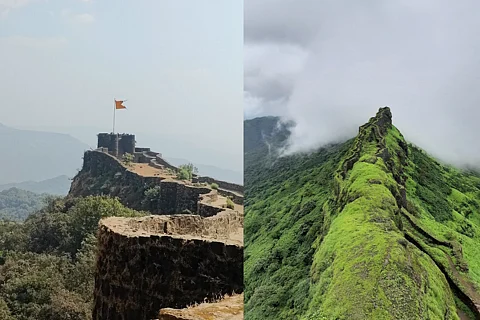
- HOMEGROWN WORLD
- #HGCREATORS
- #HGEXPLORE
- #HGVOICES
- #HGSHOP
- CAREERS
- ABOUT US
- CONTACT US

History can’t just live on through words. Malleable and dynamic, the written word is as unreliable as it is crucial to our understanding of ourselves and our past. We need physical relics to truly grasp the journey it took us, as a collective, to get to where we are today. Monuments aren’t just pretty places to explore; they’re snapshots of the sociocultural and political moments in which they were created.
The UNESCO World Heritage Sites are landmarks that keep our history alive. Chosen by the UNESCO World Heritage Committee, each of these sites is an important piece of our natural, cultural, and scientific legacies. One of their latest additions to their list of World Heritage Sites is the 12 Maratha Military Forts, marking India’s 44th entry to the list.
Spread across Maharashtra, with one fort in Tamil Nadu, the Maratha Military Landscapes are an artefact of the Maratha Empire. Developed over the late 17th to early 19th century, the forts were crucial in maintaining the Marathas’ military dominance. Each was built with strategic positioning in mind, stretching along the Sahyadri Range, Deccan Plateau, Konkan Coast, and the Eastern Ghats to form a cohesive network. Built under the helm of Shivaji I, the founder of the Maratha Empire, the forts didn’t just protect the empire– they were crucial to its formation.
The Maratha Forts, some previously built and then adapted for the empire’s needs and others built by Shivaji’s orders, were military bases and administrative spaces. From coast side to mountain ranges, the forts were masterfully designed to adapt to their terrain and uphold their function. The Lohagad Fort, a hill fort near Lonavala, for instance, was occupied by the Maratha to monitor trade routes due to its high position and panoramic views. Another notable fort, The Raigad Fort, had deep valleys along its periphery, was nearly impenetrable, making it the perfect base for Shivaji during his reign.
Each of these 12 forts offers us a unique insight into the Marathas’ strategy, giving us access to an unreachable piece of India’s history. You’ll find inscriptions along their walls or ruins where rooms once were, telling us about a resident’s thoughts at the time or where conflict once occurred. The promise of their protection under UNESCO’s watch is also a promise that important Indian knowledge will not be lost to vandalisation or decay. As important as documentation through writing is, this is the true heart of cultural conservation.
If you enjoyed reading this, here’s more from Homegrown:
Masks, Myths, & Memory: The Queer Cinematic Legacy Of Rituparno Ghosh
The Indigo Revolt: When Colonial-Era Bengali Farmers Rebelled Against The British Raj
What The Maharashtra Special Public Security Bill Could Mean For Civil Liberties In India
